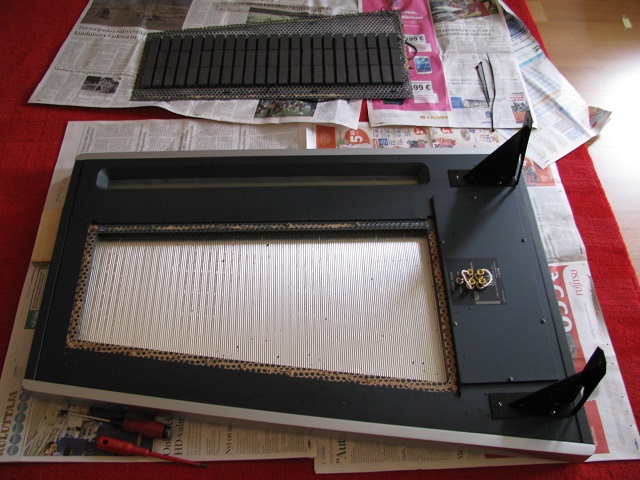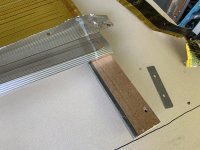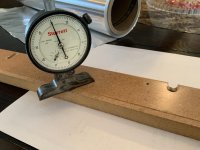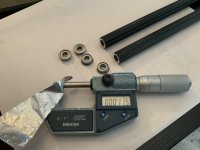Since the silicon treatment is permanent and cannot be undone if misapplied, I would try this first:
Someone else tried the foam weatherstrip with a sticky side taped to the brace and the foam touching the panel. I would try a similar foam strip WITHOUT the sticky side and just press it into the area of the old foam.
Since most of these strips are about 1/2-in to 3/4-in wide, you may need to trim them down a bit.
If this resolves the buzz, the you apply can the silicone to keep the new foam in place against the brace. I wouldn't even do this unless I noticed the foam coming loose. Play them for a while and then inspect. If the foam is still intact, leave it alone.
Someone else tried the foam weatherstrip with a sticky side taped to the brace and the foam touching the panel. I would try a similar foam strip WITHOUT the sticky side and just press it into the area of the old foam.
Since most of these strips are about 1/2-in to 3/4-in wide, you may need to trim them down a bit.
If this resolves the buzz, the you apply can the silicone to keep the new foam in place against the brace. I wouldn't even do this unless I noticed the foam coming loose. Play them for a while and then inspect. If the foam is still intact, leave it alone.
That's a really narrow gap, and if you press something in you have the potential to damage/deform/deflect the transducer. And, you're only able to do this on one (the front) side of the transducer anyways.
The silicone application really is the best (by far) repair treatment you can perform on the speakers.....short of the expensive rebuild procedure.
Dave.
The silicone application really is the best (by far) repair treatment you can perform on the speakers.....short of the expensive rebuild procedure.
Dave.
The Stage is a much easier procedure, of course.
It's more challenging with non-Stage speakers, but still doable. The speaker must propped up on its side (one side, then the other) and well-secured. The application through the perforated magnet plate is tedious and time-intensive, but you will be rewarded in the end.
Dave.
It's more challenging with non-Stage speakers, but still doable. The speaker must propped up on its side (one side, then the other) and well-secured. The application through the perforated magnet plate is tedious and time-intensive, but you will be rewarded in the end.
Dave.
John,
I really appreciate this post... like yourself, I was new owner of a used pair of duetta signature for short time before the hissing and resonance problem began to ruin the honeymoon with these speakers.
I don't have the $$ to have it professionally restore, so I'm eager to try out the foam fix you shared.
You instructions are great, but I'm stuck in the starting line as I look at the back of the speaker, I can't even figure out how to get pass the sock of the speaker and how to get to the foam...
I can't find any screws that how the back and front together...
for those of you who have done this fix already, you must have found the trick...please enlighten me!!
Thanks.
Gerald
I really appreciate this post... like yourself, I was new owner of a used pair of duetta signature for short time before the hissing and resonance problem began to ruin the honeymoon with these speakers.
I don't have the $$ to have it professionally restore, so I'm eager to try out the foam fix you shared.
You instructions are great, but I'm stuck in the starting line as I look at the back of the speaker, I can't even figure out how to get pass the sock of the speaker and how to get to the foam...
I can't find any screws that how the back and front together...
for those of you who have done this fix already, you must have found the trick...please enlighten me!!
Thanks.
Gerald
I may be undertaking this task soon...
1. Has the recipe for this treatment been updated or changed at all?
2. Roughly how much is required for a pair?
3. Should I do one length of foam and then wait for it to dry before flipping over to the next length (both on the same side here, not the backside yet)? Is appears that you guys are not waiting before proceeding to the next length. My fear is that it will drip if I flip but I guess not since noone is reporting this. I plan on freezing any mixture for the next day.
4. If anyone wants to chime in with any other tricks or things to consider please do so.
Thanks for your help. Great thread!
1. Has the recipe for this treatment been updated or changed at all?
2. Roughly how much is required for a pair?
3. Should I do one length of foam and then wait for it to dry before flipping over to the next length (both on the same side here, not the backside yet)? Is appears that you guys are not waiting before proceeding to the next length. My fear is that it will drip if I flip but I guess not since noone is reporting this. I plan on freezing any mixture for the next day.
4. If anyone wants to chime in with any other tricks or things to consider please do so.
Thanks for your help. Great thread!
Hi all, I used silicone mold from illuseffects, which I cut with silicone oil 100cst... this mix can be rendered very flowable, whilst the silicon mold retains good elastic density... it worked pretty good for me, and also the advantage I found is that the silicone mold doesn't stick that much to the apogee alu. panel. So lay edge to be cured horizontal with a little tilt to retain the mix and prevent it flow off the corner edge panel / timber... flow the mix with a syringe, with little overflow, for it to flow inbetwen panel and timber brace to the foam, repeat till it absorbs any more. At least this worked well for me since 2 yrs now.
I am rebuilding a set of Divas and noticed the actual gap or channel where the foam lays in is relatively tight when everything is buttoned up.
The foam used is the light open cell type and compresses down significantly.
I can see why it had a short life under these conditions.
I am in the process of making my own panels and have purchased 1100 soft temper .001” foil and Kapton with adhesive backing.
Time will tell if I can actually pull this off..,.BTW
The question is has anybody used the closed cell foam , usually grey in color with more density along with opening up and angling the gap so there is a progressive compression instead of an equally flat compression of the foil edge ?
I would have to cut the channels deeper because this foam is thicker than the originals
The angles toward the foil edge would then be less than the deeper section.
Your thoughts on this ?
Regards
David
The foam used is the light open cell type and compresses down significantly.
I can see why it had a short life under these conditions.
I am in the process of making my own panels and have purchased 1100 soft temper .001” foil and Kapton with adhesive backing.
Time will tell if I can actually pull this off..,.BTW
The question is has anybody used the closed cell foam , usually grey in color with more density along with opening up and angling the gap so there is a progressive compression instead of an equally flat compression of the foil edge ?
I would have to cut the channels deeper because this foam is thicker than the originals
The angles toward the foil edge would then be less than the deeper section.
Your thoughts on this ?
Regards
David
artm ................. 4. If anyone wants to chime in with any other tricks or things to consider please do so. ................. 


